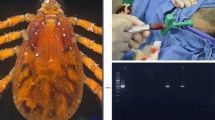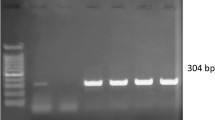Abstract
The present study was planned to investigate the molecular prevalence of canine monocytic ehrlichiosis (CME) in dogs in and around Hisar and to evaluate the haemato-biochemical profile for its better management. A total of 60 dogs presented to Medicine Section, TVCC, LUVAS, Hisar with the history of naturally acquired tick infestation and clinical signs consistent with CME were screened on the basis of blood smear examination, followed by molecular detection by nested PCR assay targeting a portion of 16S rRNA gene of Ehrlichia canis. Nested PCR detected 18 cases positive for E. canis with estimated 30% percent positivity as compared to 8.33% (5 out of 60) by blood smear examination. These 18 dogs confirmed for CME by nested PCR were assessed for clinical and haemato-biochemical profile. Breed-wise prevalence indicated maximum number of cases in Labrador retriever, followed by Pug, Rottweiler and German shepherd dog with more number of cases in male dogs. Age-wise prevalence revealed highest number of cases in more than 1 year age group, followed by 6 months to 1 year age group and least in less than 6 months aged dogs. Pyrexia, anorexia and pale to congested mucous membranes were the main clinical signs observed, followed by lethargy, vomiting. Less common clinical signs were epistaxis, lymphadenomegaly, hind limb weakness, malena, ocular discharge, followed by haematuria, corneal opacity, nasal discharge and coughing, icterus, dermal petechiae and ecchymoses. The haematological profile revealed macrocytic hypochromic anaemia, thrombocytopenia, normal leucocyte count with relative lymphocytosis, monocytosis and neutropenia. Serum biochemistry revealed significant rise in values of ALT, AST, GGT, bilirubin total, bilirubin indirect, alkaline phosphatase and A/G ratio in affected dogs as compared to healthy control, suggesting the hepatic dysfunction. The lipid metabolites and kidney function parameters were non-significantly altered from those of healthy control. A high positivity for E. canis detected by nested PCR in dogs in and around Hisar suggests the endemicity of the disease in dogs’ population in this region and warrants the screening for the disease in suspected dogs by this technique as compared to routine blood smear examination. The presented haemato-biochemical profile may be useful in presumptive diagnosis of the disease in dogs and their better clinical management.

Similar content being viewed by others
References
Abd Rani PAM, Irwin PJ, Coleman GT, Gatne M, Traub RJ (2011) A survey of canine tick-borne diseases in India. Parasites Vectors 4:141–148
Agnihotri D, Khurana R, Jain VK, Singh G (2012) Concurrent infection of Ehrlichia canis and ancylostomosis in a dog. Indian Vet J 89(11):89–90
Avery AC, Avery PR (2007) Veterinary clinics small animal practice determining the significance of persistent lymphocytosis. Vet Clin Small Anim 37:267–282
Bhadesiya CM, Raval SK (2015) Hematobiochemical changes in ehrlichiosis in dogs of Anand region, Gujrat. Vet World 8(6):713–717
Bhardwaj RK (2013) Therapeutic management of acute canine monocytic ehrlichiosis. Indian Vet J 90(2):138–139
Breitschwerdt EB, Hegarty BC, Hancock SI (1998) Sequential evaluation of dogs naturally infected with Ehrlichia canis, Ehrlichia chaffeensis, Ehrlichia equi, Ehrlichia ewingii, or Bartonella vinsonii. J Clin Microbiol 36:2645–2651
Castro DB, Machado RZ, Tomaz de Aquino LP, Alessi AC, Costa MT (2004) Experimental acute canine monocytic ehrlichiosis: clinicopathological and immunopathological findings. Vet Parasitol 119(1):73–86
Coles EH (1986) Veterinary clinical pathology, 4th edn. WB Saunders Company, London, pp 46–47
Das M, Konar S (2013) Clinical and hematological study of canine ehrlichiosis with other hemoprotozoan parasites in Kolkata, West Bengal, India. Asian Pac J Trop Biomed 3(11):913–915
Dhankar S, Sharma RD, Jindal N (2011) Some epidemiological observations on canine ehrlichiosis in Haryana and Delhi states. Haryana Vet 50:9–14
Dixit AK, Dixit P, Sukla PC (2012) Canine monocytic ehrlichiosis and its therapeutic management in a dog. Intas Polivet 13(1):140–141
Frank JR, Breitschwerdt EB (1999) A retrospective study of ehrlichiosis in 62 dogs from North Carolina and Virginia. J Vet Intern Med 13:194–201
Gaunt SD, Beal MJ, Stillman BA, Lorentzen L, Diniz PPVP, Chandrashekar R, Breitschwerdt EB (2010) Experimental infection and co-infection of dogs with Anaplasma platys and Ehrlichia canis: hematologic, serologic and molecular findings. Parasites Vectors 3:33
Groves MG, Dennis GL, Amyx HL, Huxsoll DL (1975) Transmission of Ehrlichia canis to dogs by ticks (Rhipicephalus sanguineus). Am J Vet Res 36:937–940
Harrus S, Waner T (2010) Diagnosis of canine monocytotropic ehrlichiosis: an overview. Vet J 187:292–296
Harrus S, Waner T, Eldor A, Zwang E, Bark H (1996) Platelet dysfunction associated with experimental acute canine ehrlichiosis. Vet Rec 139:290–293
Harrus S, Waner T, Bark H, Jongejan F, Cornelissen AW (1999) Recent advances in determining the pathogenesis of canine monocytic ehrlichiosis. J Clin Microbiol 37:2745–2749
Heeb HL, Wilkerson MJ, Chun R (2003) Large granular lymphocytosis, lymphocyte subset inversion, thrombocytopenia, dysproteinemia, and positive Ehrlichia serology in a dog. J Am Anim Hosp Assoc 39:379–384
Hildebrandt PK, Huxsoll DL, Walker JS, Nims RM, Taylor R, Andrews M (1973) Pathology of canine ehrlichiosis (Tropical canine pancytopenia). Am J Vet Res 34:1309–1320
Iqbal Z, Chaichanasiriwithaya W, Rikihisa Y (1994) Comparison of PCR with other tests for early diagnosis of canine ehrlichiosis. J Clinical Microbiol 32:1658–1662
Komnenou AA, Mylonakis ME, Kouti V, Tendoma L, Leontides L, Skountzou E, Dessiris A, Koutinas AF, Ofri R (2007) Ocular manifestations of natural canine monocytic ehrlichiosis (Ehrlichia canis): a retrospective study of 90 cases. Vet Ophthalmol 10:137–142
Lakshmanan B, John L, Gomathinayagam S, Dhinakarraj G (2006) Prevalence of Ehrlichia canis in Chennai. Indian Vet J 7:307–312
Lakshmanan B, John L, Gornathinayagam S, Dhinakarraj G (2007) Molecular detection of Ehrlichia canis from blood of naturally infected dogs in India. Vet Archive 83:353–354
Milanjeet HS, Singh NK, Singh ND, Singh C, Rath SS (2014) Molecular prevalence and risk factors for the occurrence of canine monocytic ehrlichiosis. Vet Med 59:129–136
Morais CDN, Castro DRJ, Mundim VA, Bastos DEJ, Ferreira AF, Souza AM, Salaberry SRS, Lima-Ribeiro CMA (2010) Clinical and hematological aspects of dogs naturally infected with Ehrlichia spp. and Leptospira interrogans. Biosci J 27(3):452–459
Murphy GL, Ewing SA, Whitworth LC, Fox JC, Kocan AA (1998) A molecular and serological survey of Ehrlichia canis, E. chaffeensis, and E. ewingii in dogs and ticks from Oklahoma. Vet Parasitol 79:325–339
Mylonakis ME, Koutinas AF, Billinis C, Leontides LS, Kontos V, Papadopoulos O, Rallis T, Fytianou A (2003) Evaluation of cytology in the diagnosis oxf acute canine monocytic ehrlichiosis (Ehrlichia canis): a comparison between five methods. Vet Microbiol 91(2–3):197–204
Nair AD, Cheng C, Ganta CK, Sanderson MW, Alleman AR, Munderloh UG, Ganta RR (2016) Comparative experimental infection seen in dogs with E. canis, E. chaffensis, A. platys and A. phagocytophilum. PLoS One 11(2):e0148239
Nakaghi AC, Machado RZ, Costa MT, Andre MR, Baldani CD (2008) Canine ehrlichiosis: clinical, haematological, serological and molecular aspects. Cien Rural Santa Maria 38(3):766–770
Osathanon R, Moonarmart W, Suksantilap N, Krajangpit N, Lekcharoensook P, Julapanthong P, Wongrerkngam N (2013) Evaluation of hematology profiles and measurement of serum cardiac troponin level in canine monocytic ehrlichiosis. Thai J Vet Med 43(3):411–419
Parmar C, Pednekar R, Jayraw A, Gatne M (2013) Comparative diagnostic methods for canine ehrlichiosis. Turk J Vet Anim Sci 37:282–290
Prashar R, Sudan V, Jaiswal KA, Srivastava A, Shanker D (2015) Evaluation of clinical, biochemical and haematological markers in natural infection of canine monocytic ehrlichiosis. J Parasitic Dis. doi:10.1007/s12639-015-0688-7
Reardon MJ, Pierce KR (1981) Acute experimental canine ehrlichiosis. I. Sequential reaction of the hemic and lymphoreticular systems. Vet Pathol 18:48–61
Ristic M, Holland CJ (1993) Canine ehrlichiosis. In: Woldehiwet Z, Ristic M (eds) Rickettsial and chlamydial diseases of domestic animals. Pergamon Press, New York, pp 169–186
Shaw SE, Day MJ, Birtles RJ, Breitschwerdt EB (2001) Tick-borne infectious diseases of dogs. Trends Parasitol 17:74–80
Silva GCF, Benitez AN, Girotto A, Taroda A, Vidotto MC, Garcia JL, Freitas JC, Headley SA, Vidotto O (2012) Occurrence of Ehrlichia canis and Anaplasma platys in household dogs from Northern Parana. Rev Bras Parasitol Vet 21:379–385
Silva LS, Pinho FA, Maria G, Prianti MG, Braga JFV, Pires JV, França SA, Silva SMMS (2016) Renal histopathological changes in dogs naturally infected with Ehrlichia canis. Braz J Vet Pathol 9(1):2–15
Srikala D, Satish Kumar K, Amruth Kumar VV, Tirumala Rao DS (2012) Clinical and therapeutic aspects of canine monocytic ehrlichiosis. Indian J Vet Med 32(2):109–110
Srivastava MK, Srivastava A (2011) Canine ehrlichiosis in dog. Indian J Vet Med 31(2):128–129
Taylor MA, Coop RL, Wall RL (2007) Parasites of dogs and cats. In: Taylor MA, Coop RL, Wall RL (eds) Veterinary parasitology, 3rd edn. Blackwell Publishing, Oxford, p 356–458
Thirunavukkarasu PS, Dhanapalan P, Gnanaprakasam V (1993) Incidence of canine ehrlichiosis in Madras city. Cheiron 22:222–224
Thirunavukkarasu PS, Nambi AP, Rajan TSS, Gnanaprakasam V (1994) Clinical and haematological findings in canine ehrlichiosis in Madras city. Indian Vet J 71:825–828
Troy GC, Vulgamott JC, Turnwald GH (1980) Canine ehrlichiosis: a retrospective study of 30 naturally occurring cases. J Am Anim Hosp Assoc 16:181–187
Waner T, Harrus S, Weiss DJ, Bark H, Keysary A (1995) Demonstration of serum anti-platelet antibodies in experimental acute canine ehrlichiosis. Vet Immunol Immunopathol 48:177–182
Waner T, Harrus S, Bark H (1999) Canine monocytic ehrlichiosis—an overview. Israel Vet Med A 54(4):1–8
Weiser MG, Thrail MA, Dulton R, Beck ER, Wise LA, Vansteenhouse JL (1991) Granular lymphocytosis and hyperproteinemia in dogs with chronic ehrlichiosis. J Am Anim Hosp Assoc 27(1):84–88
Wen B, Rikihista Y, Mott JM, Grene R, Kim HY, Zhi N, Couto C, Unver A, Bartsch R (1997) Comparison of nested PCR with immunofluorescent-antibody assay for detection of Ehrlichia canis infection in dogs treated with doxycycline. J Clin Microbiol 35:1852–1855
Woody BJ, Hoskins JD (1991) Ehrlichial diseases of dogs. Vet Clin North Am Small Anim Pract 21:75–98
Author information
Authors and Affiliations
Corresponding author
Rights and permissions
About this article
Cite this article
Bai, L., Goel, P., Jhambh, R. et al. Molecular prevalence and haemato-biochemical profile of canine monocytic ehrlichiosis in dogs in and around Hisar, Haryana, India. J Parasit Dis 41, 647–654 (2017). https://doi.org/10.1007/s12639-016-0860-8
Received:
Accepted:
Published:
Issue Date:
DOI: https://doi.org/10.1007/s12639-016-0860-8




